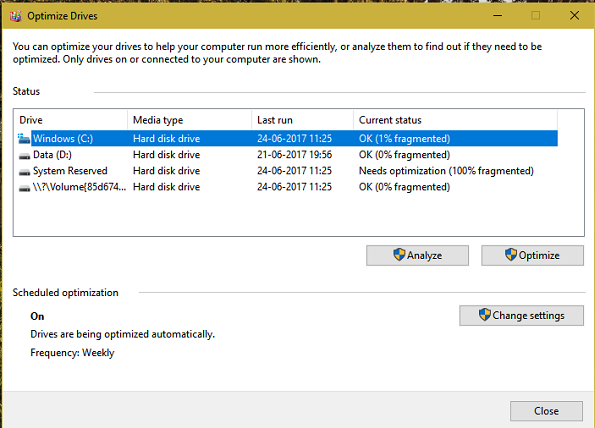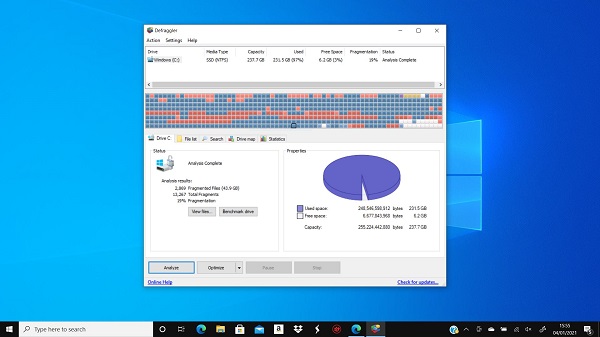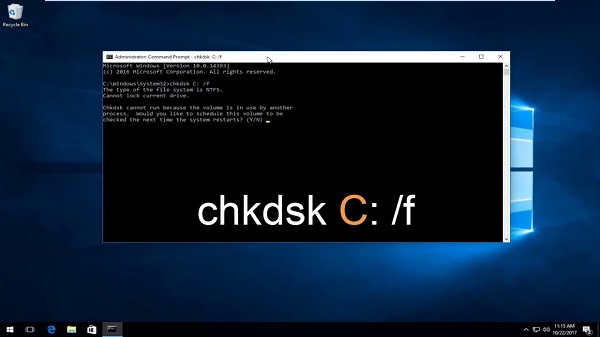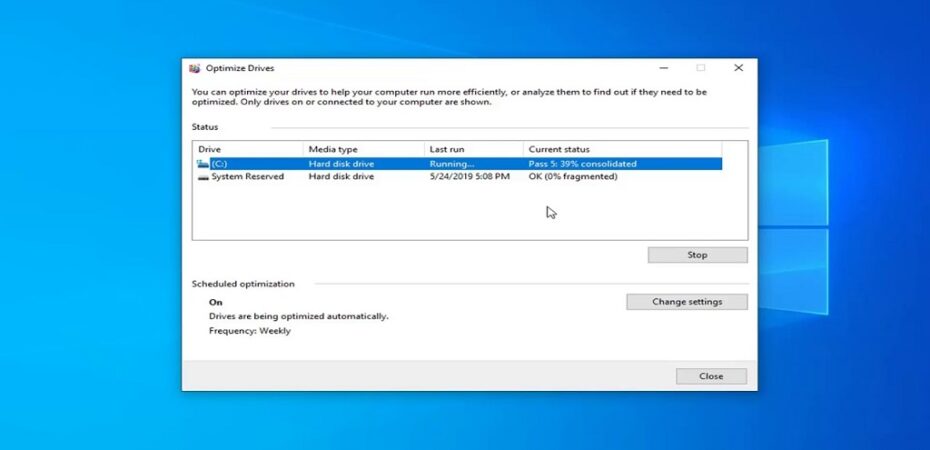HDDs are intrinsically slower than SSDs due to technological differences, and their performance degrades as time passes while you store increasing amounts of data on them. This is because data fragmentation occurred during the writing procedure. Nevertheless, there is a straightforward solution known as defragmentation. In this article, we’ll go over a few basic methods for defragging your Windows hard disc and getting a noticeable performance gain.
What Does Defragmentation Mean?
For an understanding of defragmentation, we must first start by learning about fragmentation. Fragmentation is the process of dispersing data over several sectors of a hard disk. It frequently occurs when no contiguous memory exists for holding a file. In such cases, the file is divided into numerous data pieces and distributed across separate hard disc blocks. So defragmentation is, you may have guessed it already, a procedure that brings scattered fragments of data together.
Fragmentation isn’t much of an issue if you have enough free storage on your PC. However, when space is limited, it becomes more difficult for the hard drive to divide up data in continuous blocks. The situation worsens when files are relocated, removed, or edited from the hard disc over time.
In such circumstances, the data is distributed across multiple sectors of the hard drive. It basically indicates that the hard disk requires an extended amount of time to get to the scattered data, lowering the read/write efficiency and overall performance. As a result, we need to defrag Windows 10 on a regular basis to keep file pieces closer together. As a result, your Windows PC will run faster.
Is It Necessary To Defragment Windows 10?

You must, of course. Windows 10, on the other hand, automatically defragments the hard disk on a weekly basis. The good news is that Windows enabled it by default. When Windows detects that your computer is inactive, it launches a background job that defragments Windows 10. If you want to see when your hard drive was last defragged, click Windows and R at the same time and type “dfrgui.” Now press the enter key.
The Defragmentation window will be displayed. Under the “Last run” heading, you may view all the information on the most recent defragmentation. You don’t need to do anything if Microsoft Windows 10 is defragmenting your hard disc on a regular basis.
Keep in mind that you should not defragment your Windows 10 if you use a laptop with a solid-state drive (SSD). SSDs use an alternative technology to mechanical hard drives. SSDs have a restricted read/write count, and repeated defragmentation will further reduce their lifespan. As a result, if you are using an SSD, you should never defrag it. To determine the type of RAM storage, reopen the Run window by clicking Windows and the R key. Then, type dfrgui and press enter. The necessary information can be found under the “Media type” label.
Why Did The Disk Defragmenter Stop Working?
Although a disc defragmenter is crucial for your computer’s smooth work, it may not always function properly. Several factors can cause the disk defragmenter to quit working:
- If you’re using a solid-state drive (SSD), the tool will not operate. SSDs do not require defragmentation since they lack the moving parts seen in traditional hard drives.
- Another possibility is that your machine has a virus or malware interfering with the disc defragmenter. You might try performing a scan for viruses to find out if that resolves the issue.
- Corrupted system files could trigger the service to fail. In such a circumstance, performing a System File Checker (SFC) scan to detect the problem may be worthwhile.
Now that we are aware of what causes the Disk Defragmenter to stop operating let’s look at some alternatives that may assist you in resolving the issue. If you are dissatisfied with the planned defragmentation or prefer to defragment Windows 10 manually, continue reading to learn about how to defrag a computer processes in detail.
How To Defragment Windows 10 in 2023

If you wish to manually perform Windows 10 defrag, here are three possible methods. You can select any of them based on what is most convenient for you. So, without further ado, let’s learn how to defragment windows 10:
Find Out The Status Of The Disk Defragmenter
If your personal computer is performing slowly, one possible cause is that the Disk Defragmenter function is not correctly executing. This service aids in hard drive performance by reorganizing files to ensure they may be read faster and more effectively.
To see if the Disk Defragmenter service is operating correctly, perform the following steps:
- Open the Services application,
- Scroll down and double-click on the “Optimize drives” service.
- Change the Start type to “Manual” using the drop-down option.
- Check that the service’s status is “Running.” If it isn’t, click Start to start it.
- To save it, click Apply > OK.
Check to see if the adjustments as mentioned above have resolved the issue. Otherwise, proceed to the following solution.
Launch the System File Checker function.
Launch the System File Checker program to repair your disk defragmenter. This utility will check your entire system for corrupt or missing files and replace them.
Follow these steps to execute a System File Check:
- Press Win + X on the keyboard to access the Power User menu.
- Choose the Run option in the menu.
- Enter “cmd” in the Run command dialog box, then press Ctrl + Shift + Enter simultaneously.
- Select Yes to grant administrator access when UAC comes on the screen.
- Type “sfc/scannow” in the Command Prompt window and hit Enter.
Be patient, as the scan could take some time to complete. When the scan is finished, restart the system and start Disk Defragmenter again. It should now function properly.
If your Disk Defragmenter tool is still not working after conducting an SFC scan, you might have to utilize the DISM utility. To do so, use Command Prompt as a system administrator and enter the following command line:
DISM /Online /Cleanup-Image /ScanHealth\nDism.exe /online /cleanup-image /restorehealth
After the scan, restart the computer, then try defragmenting again.
Perform the CHKDSK Utility

If the Disk Defragmenter on your PC continues to fail to function, you may attempt to run the CHKDSK tool. It’s a computer program that checks the health of your hard disk and identifies and fixes faults.
To use the CHKDSK utility, perform the following steps:
- Look for “Command Prompt” using the Windows key.
- Run as administrator by right-clicking on the search result.
- If UAC appears on your computer screen, select Yes. This will launch a Command Prompt using administrative privileges.
- When you’re at Command Prompt, type and hit Enter the following command:
chkdsk C: /f
Note: The letter “C:” in the above command denotes your drive; swap it with the letter corresponding to your drive.
When the scanning procedure is finished, and you have received notification that your disk has been checked, attempt to defragment it once more.
As it goes, according to the size of the partition, the scan may take a while to finish, and it occasionally appears to become stuck. However, it would be best if you allowed it to perform its duty without interruption.
Shut Down All Third-Party Apps
If you have any third-party software running, it could cause problems with Disk Defragmenter. Shut down all third-party programs to see whether this helps the defragmenter work properly.
If you close all open windows and the defragmenter still has problems, a background process may be interfering with it. As a result, you can try terminating some third-party processes to see if that resolves the issue.
- To access the Task Manager, simultaneously press Ctrl + Shift + Esc on the keyboard.
- Locate an unnecessary third-party service on the Processes tab, then right-click on it.
- After that, from the context menu, choose End task.
Check to see whether the disk defragmenter is working again after shutting one. If it does, whatever service you just shut off is to blame. You can now update, reinstall, or delete the troublesome app to prevent it from messing with Disk Defragmenter.
Frequently Asked Questions
What are the advantages of defragmenting your hard drive?
When your computer generates a new file, it stores it in fragments in numerous locations. Whenever you wish to access that file, you’ll have to go through all of the places where the data is kept. This takes longer since your system scans your disk several times. Defragmenting your drive will combine the various pieces of data together and, as a result, improve the speed of your device.
Are there any reasons why you should not defrag your computer?
If your computer contains a mechanical hard disk or an external hard disk, you should always defrag those disks. The only exception is when your computer exclusively uses a Solid State Drive (SSD) or an M.2 NVMe Drive, which are contemporary versions of mechanical drives that routinely defrag themselves without requiring involvement. If you defragment these hard drives, it will do nothing at best, but it can also lead to unnecessary damage if done repeatedly.
How often should you perform defrag on a hard drive?
Most Windows users should be good with defragging their hard drives once a month. Set a monthly cleansing cycle for your hard disk using your PC’s built-in “scheduled optimization” feature. It not only eliminates the requirement to do it manually, but it also enhances the efficiency of your hard drive. If routine defragmentation of the hard drive does not improve its performance, you might want to consider upgrading to an SSD.
Bottom Line
If you use hard disks instead of solid-state drives, you have to defrag computer HHDs once every few months. This will improve the efficiency of the HDD by organizing all of the data in a single location. It will also make the read and write processes go more smoothly.
We can see from the content that fragmentation is no more an issue on Windows 10 because automated defragmentation has been included in the operating system. Nonetheless, if you would like to defragment Windows 10 manually, you are welcome to do so. If the computer continues to be slow after defragging, you may have something else going on. In this instance.
Read also:
- Windows Defender vs Avast
- 7 Solutions To Fix SD Card Recognized On Windows
- How to Fix “Error Code: 0x0 0x0” on Windows?
- How to Fix “Windows Smartscreen Can’t Be Reached” Error
- How to Fix Broken Registry Items In Windows 10
- How To Fix Kernel Security Check Failure stop code in Windows 10
- How to Check How Much VRAM You Have on Windows 10?

